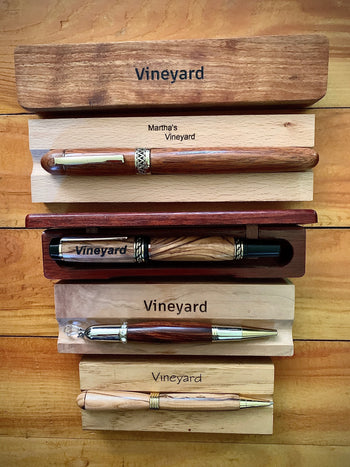
WHEN SHOPPING FOR A CUSTOM PEN, THERE ARE THREE DIFFERENT STYLES YOU MIGHT CONSIDER: BALLPOINTS, ROLLERBALLS, AND FOUNTAIN PENS.
Each category has its own benefits and limitations, which are outlined below.
Ballpoint Pens are the most common style of pen thanks to their versatility and cost-effectiveness. Most “regular” pens use ballpoint technology, so you are almost certainly familiar with this style of writing. Due to their design and the ink typically used in ballpoints, these pens are capable of writing effectively on a variety of different mediums and paper types. Celebrated for reliability, versatility, and functionality, ballpoints offer the best bang for the buck for an easy-to-use writing instrument. Because of the writing mechanics (ballpoints require pressure and movement to dispense ink), these are safe to carry in a pocket or bag without fear of ink bleeding. Additionally, ballpoints will not dry out if left uncapped, which is a concern for other types of pens. The downside of the ballpoint design is that they require constant pressure when writing, which accounts for the familiar hand aching after continued writing. Furthermore, because ballpoint ink is dispensed via an ever-turning ball tip, the ink lines will never be as smooth or unbroken as those from rollerballs or fountain pens. Ballpoints get the job done, but the quality of the ink line will never match the gorgeous flow of ink from the other pen types.
Pros: Cost-effective, versatile, good pocket pens, easy to use, familiar, quick drying
Cons: Inferior ink flow, will tire hand muscles, can feel scratchy
Who will love: People on the move, who are not tied to their desk. Great for quick note taking on-the-go. Lefties love ballpoints because they will never smudge.
Rollerball Pens are often considered a “step-up” from ballpoints for people who regularly write with an ink pen. Rollerball technology allows ink to flow out of the tip from an ink reservoir, mimicking the flow of a luxury fountain pen. Therefore, these pens are viewed as a hybrid between ballpoints and fountains; they write smoothly but don’t require the finesse of a fountain pen. Rollerballs require far less pressure to write than ballpoints, so they will not strain the hand muscles. Rollerballs are typically slightly wider in grip, which also offers improves the feel and control of the writing instrument. While many rollerballs or commercial gel pens are known to smudge, new ink technology has eliminated this problem. The downside of rollerballs is that they are typically more expensive than ballpoints and they require more care and attention. Rollerballs must always be capped when not in use to prevent the tip from drying out. Furthermore, they will not write well on waxy paper, nor on hard surfaces without some type of padded backing (if your rollerball isn’t writing well, but an extra blank sheet of paper underneath to add some padding). These pens offer a better writing experience than ballpoints, but they also require better paper; if you mainly scribble on old napkins or on cheap waxy paper pads, you should probably avoid rollerballs.
Pros: Smooth ink flow, less strain on hand, better quality writing, best of both ballpoint and fountain pens.
Cons: Require more care and attention, more costly than ballpoints, don’t work well on cheap paper, must remain capped when not in use.
Who will love: People who write a lot and care about how their writing looks; people who use journals and notebooks, rather than just single sheets of paper or restaurant napkins; people who appreciate aesthetics, style, and enjoy customizing their experiences.
Fountain Pens are the pinnacle of luxury and offer the most authentic writing experience. Learning to use a fountain pen – especially after being conditioned to the mindlessness of ballpoint pens – can be initially challenging. Fountain pens require a delicate touch, a particular writing angle, and a deliberative mindset. Writing with a fountain pen necessitates a degree of mindfulness. Furthermore fountain pens are highly customizable, with the nib (writing point), ink type, and writing style all interacting to generate a very personalized experience. Nibs and inks are instantly interchangeable, allowing fountain pen users to tailor their writing experience to the medium or occasion. In the hands of an expert, fountain pens offer unrivaled ink flow and precision. While these may offer the best-possible writing experience, fountain pens are best suited as desk pens. Therefore, these are great for using (and prominently displaying) at home or work.
Pros: Unparalleled writing quality for experts, complete customizability, most luxurious, often crafted with best materials and designs.
Cons: Expensive, initially challenging to use, not suitable as a carry pen, must remain capped when not in use.
Who will love: People who take pride in putting deliberate thought and care into what they do; people who usually do their work and writing at the same place; people who cherish functional artistry; people who enjoy experimenting and customizing their experiences.

It’s good to know that rollerball pens have less strain on the hand and are great for notebooks and journals. I’m wanting to get in the habit of writing in a journal every night and I think having a nice pen for it will help me create that habit. To do this, I’ll have to find a good rollerball pen that I like to write in my journal. https://www.americanhardgoodsinc.com/product-page/MarbRodium-rollerball-2
Leave a comment